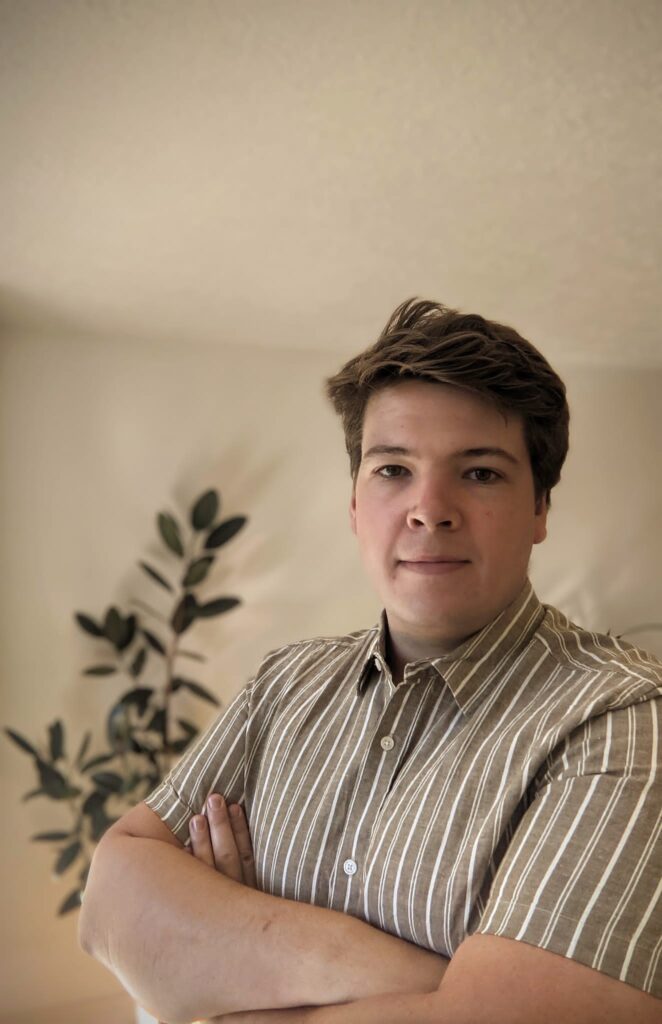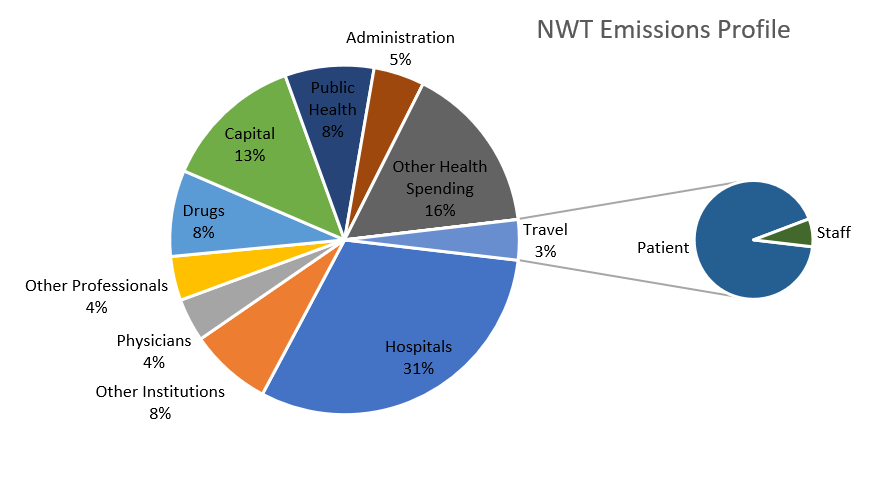Project Category: Multidisciplinary
Join our presentation
About our project
Many public and private sectors are developing strategies to address climate change and mitigate greenhouse gas (GHG) emissions; our capstone design project presents an opportunity for the healthcare system of the Northwest Territories to correspond. The primary objective for our team was to identify one or more ways to reduce the carbon emissions of the Northwest Territories healthcare system and propose recommendations for the territorial Health and Social Services Authority to adopt. The project consists of an emissions profile design and practical design solutions for two emissions categories: anesthetic gas and patient travel.

The emissions profile we have designed provides a baseline for how much each high-level expenditure category contributes to the total healthcare emissions—estimated to be between 90,000 and 98,000 tonnes of CO2e. Considering the unique living conditions and remoteness of communities in the Northwest Territories, our group focused on quantifying emissions related to patient travel and identified that the most appropriate solution would be to expand broadband infrastructure and implement a telehealth system.

In addition to patient travel, our group focused on designing an effective solution to lower emissions from the growing use of anesthetic gas usage. It was found that between 90 and 95 per cent of gas is vented out into the atmosphere as waste gas. From an economic and environmental perspective, we have determined that the most viable solution is the implementation of Blue-zone technology. We believe that our emissions profile design and solution proposals are small steps the Northwest Territories can make towards becoming net zero.
Meet our team members





Details about our design
HOW OUR DESIGN ADDRESSES PRACTICAL ISSUES
Climate change due to anthropogenic activity has been globally recognized as one of the greatest challenges to society and will continue to affect the environment and global population for decades to come. Healthcare systems around the world contribute to this issue, from single-use plastics to waste gases, and many countries have started making steps towards developing net-zero healthcare systems. The purpose of our design is to help the Northwest Territories baseline their emissions and begin the process of finding practical solutions to some of their low-hanging fruit emissions categories.
The recommendation to expand broadband infrastructure and implement a telehealth system addresses many practical issues that Northwest Territories people are facing. Due to the remoteness of some communities and lack of infrastructure or available doctors, a high number of patients must travel by plane for medical attention. Not only does this increase emissions, but it is an inconvenience for many patients. This may deter some patients from wanting to go see a doctor and increase the potential of medical issues being ignored. Also, many people must travel with an escort to address language barriers or help elders navigate unfamiliar cities. This means that two people are traveling for one medical reason and are emitting twice as much CO2e. A telehealth system would allow for many patients to be seen and have consultations in their own communities. Through the use of online video calls with doctors, patients ignoring symptoms and not seeking help can be prevented. Lastly, the emissions from flying and accommodations would be greatly decreased, because patients and their escorts would not need to travel by plane to get medical attention.
To address anesthetic gas related emissions, the solution we have recommended addresses climate impacts from the high GWP of these gases, as well as the occupational health risks associated with working around waste anesthetic gas. By implementing Blue-zone technology, almost all of the waste anesthetic gas can be captured and then recycled and reused. This will lower costs and almost completely eliminate this category’s emissions. Since the use of anesthetics is continually increasing, this technology will also prevent this category’s emissions from growing at the same rate.
WHAT MAKES OUR DESIGN INNOVATIVE
The most innovative aspect of our design is the emissions profile because health care related emissions have never been baselined in the Northwest Territories before. Our group decided that the emissions profile was essential to the rest of the project because, without an idea of the emission sources, we could not move forward with a reduction plan. We created this profile by utilizing a number of different resources such as environmental input-output LCA models, real data provided by the Northwest Territories Government, and extended research to calculate patient travel.
The solutions for patient travel and anesthetics are also innovative in that they are newer technologies. Blue-zone’s patented design for capturing and recycling anesthetic gases is still fairly new and is starting to see a growth in hospital subscriptions. As for a virtual health system, the Covid-19 pandemic has really brought to light how efficient these systems can be.
WHAT MAKES OUR DESIGN SOLUTION EFFECTIVE
Our design solutions are effective because of how feasible they are. Blue-zone is a technology that could be implemented in the Northwest Territories today. There are no capital costs to this service and no infrastructure building is required. The canisters to collect the waste gas are compact and easily installed, and they collect almost all of the waste gas emitted in operating rooms, with the exception of a small amount of mask and equipment leakage. Implementing a telehealth system is not quite as easy because infrastructure is required to bring internet connectivity to remote areas. However, the federal Universal Broadband Fund initiative will bring high-internet connections to these remote communities by 2030. By strategizing a plan to create a telehealth system now, the Northwest Territories healthcare system can ensure that their patient travel emissions can start being reduced in 2030 in line with when they acquire internet access.
From the Government of Alberta, 2019
HOW WE VALIDATED OUR DESIGN SOLUTION
We validated our design primarily through extensive research and consulting with industry experts. Our group created an emissions profile by leveraging studies and two different LCA models—EIO- LCA and Open-IO Canada. We also included primary research when working with our sponsors and speaking with Government healthcare personnel. Specifically, we consulted with the CEO of Blue-zone to obtain accurate data for our economic and environmental analysis.
FEASIBILITY OF OUR DESIGN SOLUTION
We have determined that implementing a telehealth system would be feasible based on studies and areas that are already using these types of systems. The most significant obstacle that will hinder the success of the telehealth system is the construction of the necessary infrastructure, which is required to bring internet connection to remote communities. To reduce the barrier, the federal Universal Broadband Fund has set out to ensure that these communities have internet access by 2030. With the help of the federal government, this goal will be feasible creating a telemedicine system will be a simple next step.
The feasibility of our waste anesthetic design solutions was determined through an economic and environmental analysis. We also conducted a sensitivity analysis by using two different global warming potential values. We found an article that argues that flow pollutants that are released at constant levels, such as anesthetic gasses, should consider a GWP of 1 year versus the most commonly used GWP100. For both cases, utilizing Blue-zone technology would be the most successful solution from both an economic and environmental perspective.
Partners and mentors
Our project is sponsored by the Government of Northwest Territories, Department of Infrastructure, and Department of Health and Social Services. We want to specifically thank William Gagnon and Zoe Guile for their continued mentorship and support. As well, a big thank you to Kipton Lade, CEO of Blue-zone, for helping to answer our questions and provide meaningful information.
As our Academic Advisor, Dr. Joule Bergerson has provided us guidance and support throughout this project. And, finally, we want to thank our Capstone Teacher Assistant Mohsen Hassani for his support and Doctor Roes (Arief) Budiman for the opportunity to work on such a meaningful project.
References
| [1] | Environment and Climate Change Canada, “A Healthy Environment and Healthy Economy,” Environment and Climate Change Canada, Gatineau, 2020. |
| [2] | C. Howard, “Healthy Planet, Healthy People,” TEDx, Montreal, 2017. |
| [3] | Government of Northwest Territories, “2030 NWT Climate Change Strategic Framework,” Government of Northwest Territories, Yellowknife, 2019. |
| [4] | T. Bernoville, “What are Scopes 1, 2 and 3 of Carbon Emissions?,” Plan A Academy, 12 August 2020. [Online]. Available: https://plana.earth/academy/what-are-scope-1-2-3-emissions/. [Accessed 30 September 2021]. |
| [5] | G. o. N. Territories, “GHG Grant Program for Government,” 2021. [Online]. Available: https://www.inf.gov.nt.ca/en/services/energy/ghg-grant-program-government. [Accessed 10 October 2021]. |
| [6] | Government of Northwest Territories, “GHG Grant Program for Buildings and Industry,” 2021. [Online]. Available: https://www.inf.gov.nt.ca/en/services/energy/ghg-grant-program-buildings-and-industry. [Accessed 10 October 2021]. |
| [7] | International Organization for Standardization, “ISO 14064 Greenhouse gases,” 1 January 2018. [Online]. Available: https://www.iso.org/obp/ui/#iso:std:iso:14064:-1:ed-2:v1:en. [Accessed 6 October 2021]. |
| [8] | Government of Northwest Territories, “2030 NWT Climate Change Strategic Framework 2019-2023 Action Plan,” Government of Northwest Territories, Yellowknife, 2019. |
